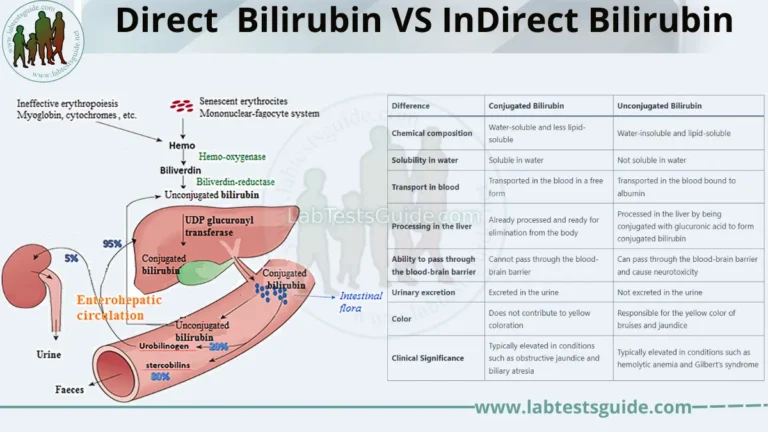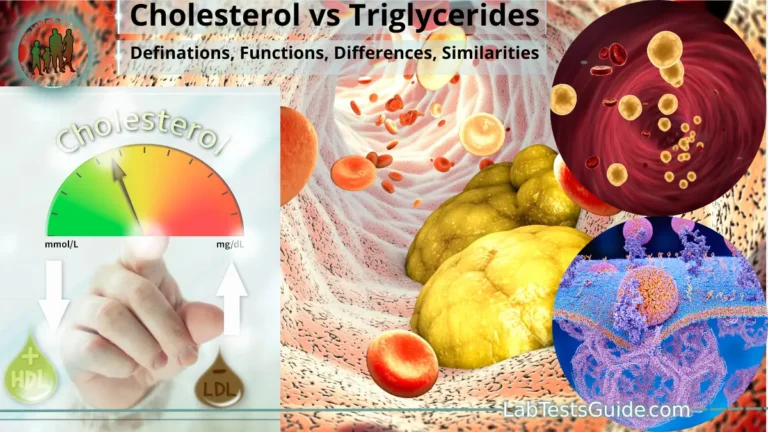Understand the differences between cholesterol and triglycerides , including their structures, functions, sources, transport mechanisms, and implications for health. Learn how cholesterol and triglycerides relate to cardiovascular health and discover management and treatment strategies for maintaining optimal levels.

Definations:
Defination of Cholesterol :
Cholesterol is a waxy, fat-like substance found in the cells of the body. It is produced primarily in the liver and is also obtained from certain foods. Cholesterol is important for various bodily functions, such as building cell membranes, producing hormones, and aiding in the digestion of fats.
Defination of Triglycerides:
Triglycerides are a type of fat (lipid) found in the blood. They are formed when the body converts excess calories, particularly from carbohydrates and fats, into storage fat. Triglycerides serve as a source of energy for the body and are stored in fat cells. Elevated levels of triglycerides in the blood can be associated with an increased risk of cardiovascular diseases.
Functions:
Cholesterol and triglycerides serve different functions in the body:
Functions of Cholesterol:
- Cell Membrane Structure: Cholesterol is an essential component of cell membranes, helping to maintain their integrity, fluidity, and stability.
- Hormone Production: Cholesterol is a precursor for the synthesis of various hormones, including sex hormones (estrogen, progesterone, testosterone) and adrenal hormones (cortisol, aldosterone).
- Vitamin D Synthesis: Cholesterol is converted into vitamin D in the skin when exposed to sunlight, which is crucial for calcium absorption and bone health.
- Bile Acid Production: Cholesterol is used by the liver to produce bile acids, which aid in the digestion and absorption of dietary fats.
- Steroid Hormone Synthesis: Cholesterol is a precursor for the synthesis of steroid hormones, such as cortisol, aldosterone, and glucocorticoids, which regulate various metabolic processes in the body.
Functions of Triglycerides:
- Energy Storage: Triglycerides are the most abundant form of stored energy in the body. Excess calories from the diet are converted into triglycerides and stored in adipose tissue (fat cells) to be utilized as an energy source when needed.
- Energy Source: Triglycerides provide a concentrated source of energy for the body’s metabolic processes, supplying fuel to cells and organs.
- Insulation and Protection: Triglycerides stored in adipose tissue help insulate the body, providing thermal insulation and cushioning organs against physical impact.
- Transport of Fat-Soluble Vitamins: Triglycerides transport fat-soluble vitamins (A, D, E, and K) throughout the body, aiding in their absorption and utilization.
While cholesterol plays crucial roles in cell structure, hormone production, and other essential processes, triglycerides primarily function as an energy reserve and transportation of fat-soluble vitamins.
Difference Between Cholesterol and Triglycerides:
- Structure: Cholesterol is a sterol molecule with four interconnected rings, while triglycerides are composed of three fatty acid chains attached to a glycerol backbone.
- Function: Cholesterol is involved in building cell membranes, producing hormones, synthesizing vitamin D, and aiding in digestion, while triglycerides serve as a source of energy and insulation.
- Sources: Cholesterol can be obtained from dietary sources (animal products) and synthesized by the liver, whereas triglycerides are primarily derived from dietary fats and oils.
- Transport: Cholesterol is transported in the bloodstream by lipoproteins, namely LDL and HDL, while triglycerides are carried by very-low-density lipoproteins (VLDL).
- Health implications: Elevated LDL cholesterol levels are associated with an increased risk of atherosclerosis and cardiovascular diseases, whereas high triglyceride levels are linked to obesity, insulin resistance, and metabolic syndrome.
- Relationship to HDL: HDL cholesterol is considered beneficial for heart health, as it helps remove excess cholesterol from the bloodstream. Triglycerides do not have a direct relationship with HDL.
- Lipid panel measurements: Blood tests often measure levels of total cholesterol, LDL cholesterol, HDL cholesterol, and triglycerides as part of a lipid profile.
- Dietary impact: Dietary intake of cholesterol has a relatively small effect on blood cholesterol levels compared to saturated and trans fats. Triglyceride levels can be influenced by dietary fat intake and carbohydrate consumption.
- Medication targets: Certain medications, such as statins, are commonly used to lower LDL cholesterol levels. Medications like fibrates and omega-3 fatty acids can help lower triglyceride levels.
- Genetic conditions: High cholesterol levels can be influenced by genetic disorders like familial hypercholesterolemia, whereas genetic factors can contribute to high triglyceride levels in conditions like familial hypertriglyceridemia.
- Risk factors: High LDL cholesterol levels are often associated with factors such as poor diet, sedentary lifestyle, smoking, and obesity. Risk factors for elevated triglycerides include excessive alcohol consumption, obesity, poorly controlled diabetes, and a high-carbohydrate diet.
- Treatment approach: Lifestyle modifications, such as adopting a heart-healthy diet and engaging in regular physical activity, are important for managing both cholesterol and triglyceride levels. Medications may be prescribed based on specific lipid profiles and overall cardiovascular risk.
Table of Differences:
| Difference | Cholesterol | Triglycerides |
|---|---|---|
| Structure | Sterol molecule with four interconnected rings | Three fatty acid chains attached to a glycerol backbone |
| Function | Building cell membranes, hormone production, digestion, and more | Source of energy, insulation, and fat-soluble vitamin transportation |
| Sources | Dietary sources (animal products) and synthesized by the liver | Primarily derived from dietary fats and oils |
| Transport | Carried by lipoproteins (LDL and HDL) | Carried by very-low-density lipoproteins (VLDL) |
| Health implications | Elevated LDL cholesterol associated with atherosclerosis and CVD | High levels linked to obesity, insulin resistance, and metabolic syndrome |
| Relationship to HDL | HDL cholesterol is considered beneficial for heart health | No direct relationship with HDL |
| Lipid panel measurements | Total cholesterol, LDL cholesterol, HDL cholesterol measured | Triglyceride levels measured |
| Dietary impact | Cholesterol intake has a smaller impact compared to saturated/trans fats | Triglyceride levels influenced by dietary fat and carbohydrate intake |
| Medication targets | Statins commonly used to lower LDL cholesterol levels | Fibrates, omega-3 fatty acids used to lower triglyceride levels |
| Genetic conditions | Familial hypercholesterolemia can lead to high cholesterol levels | Genetic factors can contribute to high triglyceride levels |
| Risk factors | Poor diet, sedentary lifestyle, smoking, obesity for high cholesterol levels | Excessive alcohol consumption, obesity, poorly controlled diabetes, high-carb diet for high triglyceride levels |
| Treatment approach | Lifestyle modifications, medications targeting specific cholesterol levels | Lifestyle modifications, medications based on triglyceride levels |
FAQs:
What is the difference between cholesterol and triglycerides?
Cholesterol is a waxy substance that is crucial for various bodily functions, while triglycerides are a type of fat that serves as an energy source.
What are the main functions of cholesterol in the body?
Cholesterol is involved in building cell membranes, producing hormones, synthesizing vitamin D, and aiding in digestion.
How are cholesterol and triglycerides related to cardiovascular health?
Elevated levels of LDL cholesterol and triglycerides are associated with an increased risk of cardiovascular diseases, such as heart disease and stroke.
Can high cholesterol levels be managed without medication?
Lifestyle modifications, such as adopting a healthy diet, exercising regularly, and maintaining a healthy weight, can help manage cholesterol levels. In some cases, medication may be necessary.
Are all sources of cholesterol harmful?
No, dietary cholesterol from sources like eggs and shellfish has a relatively small impact on blood cholesterol levels compared to saturated and trans fats.
How can I lower my triglyceride levels?
Lowering triglyceride levels can involve reducing intake of refined carbohydrates and added sugars, consuming healthy fats, exercising regularly, and limiting alcohol consumption.
Can lifestyle changes, such as diet and exercise, impact cholesterol and triglyceride levels?
Yes, adopting a heart-healthy diet low in saturated and trans fats, high in fruits, vegetables, and whole grains, combined with regular exercise, can positively impact cholesterol and triglyceride levels.
What are the risk factors for high cholesterol and triglycerides?
Risk factors for high cholesterol and triglycerides include a family history of high lipids, obesity, poor diet, sedentary lifestyle, smoking, and certain medical conditions.
Can genetics play a role in high cholesterol and triglyceride levels?
Yes, genetic factors can contribute to conditions like familial hypercholesterolemia and familial hypertriglyceridemia, which can result in high cholesterol and triglyceride levels.
Are there any natural remedies or supplements to manage cholesterol and triglycerides?
Certain natural remedies and supplements, such as plant sterols, omega-3 fatty acids, and soluble fiber, may have a modest impact on cholesterol and triglyceride levels. However, it’s important to consult with a healthcare professional before starting any supplements.
How often should cholesterol and triglyceride levels be checked?
The frequency of checking cholesterol and triglyceride levels depends on various factors, including age, overall health, and risk factors. It is best to discuss with a healthcare professional to determine the appropriate testing schedule.
Possible References Used







